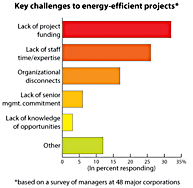
PepsiCo takes aim at the supply chain
In 2005, the company commissioned an analysis of Walkers Crisps, a product manufactured in the United Kingdom. It determined manufacturing accounted for only about 30 percent of the product’s carbon footprint. A plant program helped lower Crisps’ carbon footprint 7 percent, but additional improvements would only be possible with the cooperation of copackers and other suppliers. Key suppliers were invited to participate in the company’s Resource Conservation Model, which includes weekly data collection from utility meters, data reporting on current and year-ago energy performance, and benchmarking performance against goals.
Benchmarking has yielded surprising variations in utilities use from plant to plant. In a comparison of nine facilities producing one particular product, for example, PepsiCo concluded 1.1 kWh was the average electrical consumption for each 8-oz. bag. However, consumption at individual plants ranged from 0.2 to 3.4 kWh. By promoting a dialogue between personnel at the facilities, the company anticipates a rethinking of processes and significant efficiencies at the high-consumption sites.
PepsiCo’s supply chain program is one of several case histories on manufacturing practices in From Shop Floor to Top Floor: Best Business Practices in Energy Efficiency, a report released in April by the Pew Center.
NOAA, FDA develop test for dispersant in Gulf seafood
Using the new test in the Gulf, scientists have tested 1,735 tissue samples including more than half of those collected to reopen Gulf of Mexico federal waters. Only a few showed trace amounts of dispersants residue (13 of the 1,735), and they were well below the safety threshold of 100 parts per million (ppm) for finfish and 500 ppm for shrimp, crabs and oysters. As such, they do not pose a threat to human health.
The new test detects dioctyl sodium sulfosuccinate (DOSS), a major component of the dispersants used in the Gulf. DOSS is also approved by FDA for use in various household products and over-the-counter medication at very low levels. The best scientific data to date indicates that DOSS does not build up in fish tissues.
The 1,735 samples tested so far were collected from June to September and cover a wide area of the Gulf. The samples come from open areas in state and federal waters, and from fishermen who brought fish to the docks at the request of federal seafood analysts. The samples come from a range of species, including grouper, tuna, wahoo, swordfish, gray snapper, butterfish, red drum, croaker, shrimp, crabs and oysters.
Nearly 9,444 square miles, or about 4 percent of the federal waters in the Gulf remain closed to commercial and recreational fishing.
Food Safety Act still on hold
The measure, which concentrates food regulatory power and resources in the Food and Drug Administration, initially had significant support from the food industry, as well as consumer groups. But groups representing small farms and small food processing facilities have lobbied against the bill in recent months, charging it imposes new regulations that threaten small businesses.
Other opponents, like Sen. Tom Coburn (R-OK), object to the bill’s cost. “More money and more regulations solve nothing when Congress lacks the discipline to hold agencies accountable,” Coburn says.
Senate Majority Leader Harry Reid (D-NV) says he will bring the measure up for a vote by the full Senate once Congress reconvenes for its lame duck session after the November 2 election.
Meat and poultry processors get Fed support with exports
In a joint statement, the Office of the United States Trade Representative and Department of Agriculture said the purpose of the discussions was “to clarify technical issues and address questions.” The statement says Japan also sought clarification of developments in the US related to BSE surveillance measures, among other areas.
Chicken producers, meanwhile, got bipartisan backing from Senate Agriculture, Nutrition and Forestry Committee Chairperson Blanche Lincoln, (D-AR) and Ranking Member Saxby Chambliss (R-GA), who are urging US trade negotiators to address China’s decision to place higher duties on US poultry products.
“The actions by the Chinese are unfortunate and based on a faulty interpretation of the facts,” Chambliss says. “I find it questionable to claim the poultry industry is the recipient of subsidies, since government policy increases the price of one of their key inputs-feed grains.”
Pesticide, clean water laws under review
“This legislation provides farmers and ranchers with the safe harbor they deserve in the application of pesticides. The bill relieves producers from a potentially costly regulatory burden that does little if anything to protect the environment,” Peterson says.
Peterson says his bill will make clear that producers who are in compliance with FIFRA requirements are not subject to Clean Water Act permits.If you don't measure it, you can't control it
FULL STORY
Features
Energy efficiency dollars and sense: How do you measure up?
FULL STORY
Outsourcing sanitation and maintenance
FULL STORY
Vision, metal detection and X-ray systems
FULL STORY
Engineering R&D: Big bang theory
FULL STORY
People, Plant and Industry News
Orkin, The IPM Institute of North America and NSF International named four companies 2010 Gold Medal IPMTM Partner Award winners for their outstanding commitment to integrated pest management (IPM) partnerships. The companies are Ice River Springs (Kentland, IN), Mission Foods (Goldsboro, NC), Tarrier Foods Corp. (Columbus, OH) and The Cheesecake Factory Bakery Inc. (Calabasas Hills, CA).
McDonald’s USA recently announced it has selected Tyson Foods Inc. as its 2010 Supplier of the Year.
Denis Hennequin will resign as president of McDonald’s Europe to become chief executive officer of the Accor Hotel Group.
IDEX Corporation acquired The Fitzpatrick Company, a manufacturer of process technologies for the pharmaceutical, food and personal care markets.
Carlos Suastegui joined Valdes Engineering Company as its chief operating officer.